BRITTANY
Society

Society
Popular destinations FRANCE
| Alsace | Ardeche | Auvergne |
| Brittany | Burgundy | Cevennes |
| Corsica | Cote d'azur | Dordogne |
| Jura | Languedoc-roussillon | Loire valley |
| Lot | Normandy | Picardy |
| Provence |
Society
State structure
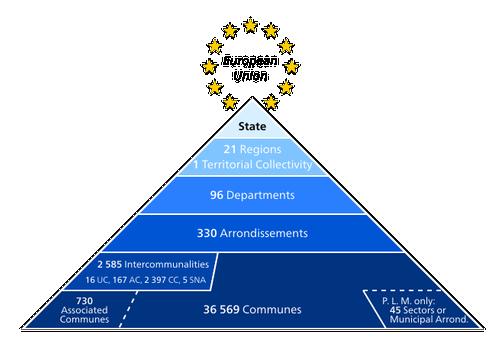 France Administrative DivisionPhoto: Public domain
France Administrative DivisionPhoto: Public domain
France is a democratic republic that originated in the year 1789, when the French Revolution ended the monarchy and the feudal form of government. There are a total of 101 departments (96 in France and 5 in the overseas territories), all of which are numbered in alphabetical order. Every six years people go to the polls to elect a departmental council. They in turn choose the day-to-day management of the department, the departmental committee. It is headed by the prefect, the representative of the national government.
The French departments are subdivided into 326 arrondissements, which in turn are subdivided into 3800 cantons. The smallest administrative units are the approximately 37,000 municipalities, most of which have less than 500 inhabitants.
The departments turned out to be too small to function properly and the country was therefore redistributed into 22 regions. Since 1986, there have been direct elections to a regional parliament, the "Conseil Régional". Regional governance is especially important for promoting the economic, social and cultural development of the region. The regional parliament is advised by an advisory committee, which includes various economic and social organizations. For the current political situation of France, see chapter history.
Breton movement
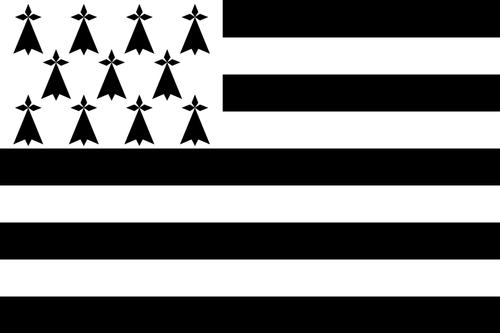 Brittany flagPhoto: Public domain
Brittany flagPhoto: Public domain
In 1893, after a wave of strikes, the first Breton nationalist movement or "Emsav" emerged, which later openly sought independence. In 1898 the Union régionaliste breton (URB) was founded, and in 1911 the first Parti national breton (PNB). The first issue of Breiz Atao ("Brittany Forever") magazine was published in 1919. After the Second World War, the struggle for Brittany's interests continued on various fronts. There were still several organizations that continued to claim autonomy or even independence. The most extreme movement was the FLB-ARB (Front Libération de Bretagne-Armée républicaine bretonne), which carried out several attacks between 1966 and 2000. This resulted in major material damage and one person was killed. The core of the current independence movements consists of the UDB (Union démocratique bretonne), Lémgann ("the struggle") and the POBL (Parti pour l'organisation d'une Bretagne libre). Individuals stick stickers with BZH (= Breizh, Brittany) or the Breton flag on their car. The flag of Brittany is the symbol for all Breton nationalists: 'gwen ha du' (white and black), the colors of the Breton flag with five black stripes symbolizing the five dioceses of Upper Brittany and the four white stripes for that from Lower Brittany.
Typically Breton.
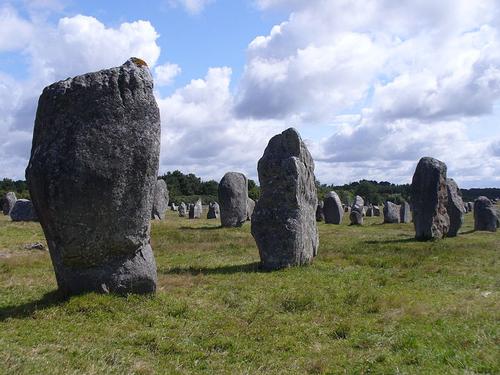 Menhirs BrittanyPhoto:Steffen Heilfort CC 3.0 Unported no changes made
Menhirs BrittanyPhoto:Steffen Heilfort CC 3.0 Unported no changes made
MEGALITES
Everywhere in Brittany one can find constructions of giant stones, dating from the 5th to the 2nd century BC. Brittany has about 5000 menhirs and 1000 dolmen. The upright menhirs ("long stones") are usually made of granite and can occur individually in rows (alignment), in circles (cromlech), or squares or quadrilaterals (quadrilatère). The main collection of menhirs is in Carnac. This seaside resort is famous for the many (2935) megalithic stones, which are arranged in long rows. In Kermario there is an alignment of 1029 menhirs arranged in ten rows and covering an area of 1120x100 meters. In Menec there are 1099 menhirs on an area of 1160x100 meters. The tumulus of Kercado, which dates back to 4670 BC, has a diameter of 30 meters and a height of 3.5 meters.
Whether menhirs had an astrological meaning or were intended for worship is not certain. The largest standing menhir in Brittany is the Menhir de Kerloas. The stone is 9.5 meters high and is located near Saint-Renan. The largest menhir in Brittany (20 m, 347 tons) is the fallen Grand Menhir of Locmariaquer; here is also a dolmen, the Table des Marchands, one of the highlights of the megalithic culture.
Dolmens or "stone tables" were originally covered with sand and were used as burial mounds. Burial mounds with stacked stones are called "cairns". On top are huge cover plates that form a corridor that provides access to various burial chambers. One of the finest examples of this architecture is located on the Île de Gravinis in the Golfe du Morbihan. The "allée couverte", a variant of the dolmen, does not distinguish between burial chamber (s) and corridor, but consists of one long corridor that at the end more or less imperceptibly merges into the burial chamber.
Megalithic Monuments
Megalith = prehistoric monument in the shape of a large stone; mostly not or very little worked and most likely used as a cult and / or funeral monument
Menhir = vertically placed elongated stone, larger and generally less worked than a stela; menhirs omen singly or in groups
Dolmen = prehistoric grave monument consisting of a number of bearing stones that bear a large capstone
Alignment = a number of menhirs arranged in a more or less straight line; often in a pattern of several parallel lines; alignements are often associated with a cromlech
Allée couverte = gallery grave, an elongated space, consisting of two rows of supporting stones with capstones on top; at the end of the allée couverte, a stone placed transversely sometimes separates a small space from the larger one
Cairn = core of stone within a tumulus
Couloir = corridor as part of a dolmen à couloir or a domen coudé; often provided with a stone-sealed entrance on the short side
Cromlech = collection of menhirs arranged in a circle, sometimes also oval
Dolmen à couloir = dolmen extended with an elongated space; sometimes the hallway contains a side room
Dolmen coudé = identical to a dolmen à couloir, but with a clear bend in the hallway
Stela = upright block of stone, generally smaller than a menhir; often provided with a carved or engraved representation
Tumulus = prehistoric burial mound
 Bernard Hinault BrittanyPhoto: Rene Boulay CC 3.0 Unported no changes made
Bernard Hinault BrittanyPhoto: Rene Boulay CC 3.0 Unported no changes made
BERNARD HINAULT
Bernard Hinault is a former French racing cyclist. He was born on November 14, 1954 in Yffignac, Cotes du Nord, Brittany.
After Jacques Anquetil (France) and Eddy Merckx (Belgium), Hinault was the third rider to win the Tour de France five times. It is remarkable that he never became world champion on the road. Over the years he drove for the teams Gitane, Gitane-Campagnolo, Renault-Gitane, Renault-Elf-Gitane and La Vie Claire.
Hinault ended his career on November 14, 1986 and has been a member of the organizing committee of the Tour de France for many years.
Hinault's nickname was "Le blaireau", the badger.
ASTERIX and OBELIX
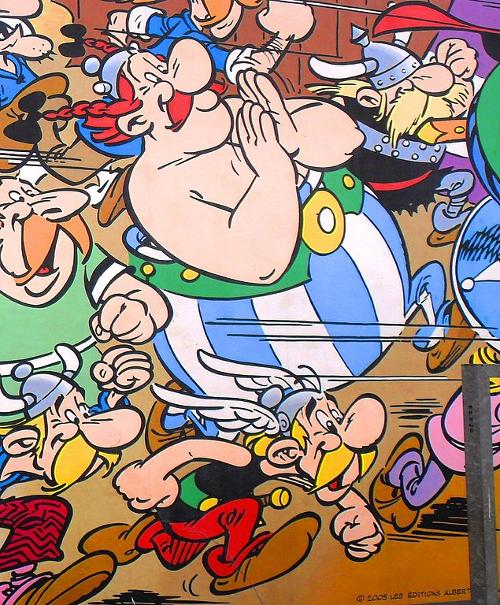 Asterix and Obelix BrittanyPhoto: Ferran Cornellà CC 3.0 Unported no changes made
Asterix and Obelix BrittanyPhoto: Ferran Cornellà CC 3.0 Unported no changes made
Asterix is the title of a series of comics created by the French cartoonist Albert Uderzo and screenwriter René Goscinny.
The original of the first story, Astérix le Gaulois, was published on October 29, 1959 in the French comic magazine Pilote. The eponymous album was released in 1961, in an edition of 6000 copies. The comics are released in more than 70 countries. After Goscinny's death in 1977, Uderzo continued releasing new stories on his own. Out of respect, Goscinny's name is still mentioned on the albums. The last album with Goscinny, "Asterix and the Belgians", was released two years after his death in 1979.
The comics tell of a village in Gaul (Brittany) that succeeded in resisting the invasion by the Romans led by Julius Caesar with the help of a magic potion that makes the Gauls extremely strong and therefore invincible. The idea of this invincibility may be traced back to a statement made by Julius Caesar in the Bello gallico: "Horum omnium fortissimi sunt Belgae", "Of them all, the Belgians are the bravest". In Roman times, Northern France still belonged to the Belgians.
Major characters:
Asterix: the main character, small but smart. The name Asterix comes from the character *, the asterisk.
Obelix: fell into the cauldron with potion as a child and therefore had enough for his life. The name Obelix comes from the French word Obèle, a cross-shaped punctuation mark. Obelix also refers to obelisk.
Idefix: Obelix's dog (from the French idée fixe).
Getafix: the druid who alone can brew the magic potion.
Abraracourcix: the chief of the village.
Assurancetourix: the bard of the village.
MONT ST-MICHEL
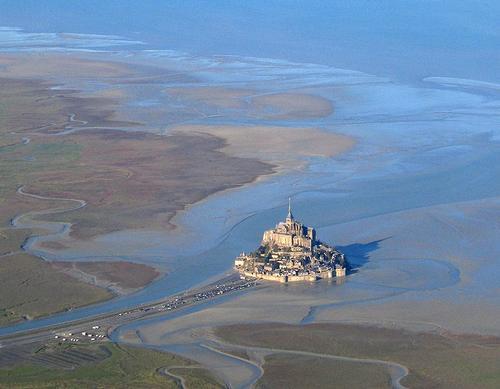
Mont St-Michel is a volcanic island protruding high above the surrounding area amid sandbanks. At the top is a beautiful abbey with a statue of the Archangel Michael at the top. This statue is located approximately 175 meters above sea level.
The abbey dates back to the 8th century when the Bishop of Avranches founded a chapel there. Fortifications were only built in the 13th century. During the French Revolution, Mont St-Michel was used as a prison, and it was not until 1966 that the abbey was again under religious occupation.
Strictly speaking, the abbey mountain lies in the Normandy part of the bay, as the border of Brittany is further west. Since 1877, a dike has made it possible to reach the island with dry feet.
Sources
Beaart, P. / Bretagne
ANWB
Bretagne
Lannoo
Bretagne
Van Reemst
Bretagne noord
ANWB
Graaf, G. de / Normandië, Bretagne
ANWB
Radius, J. / Normandië, Bretagne
Gottmer/Becht
Roger, F. / Natuurreisgids Bretagne : ontdek de onverwachte en bijzondere natuur van Bretagne
Kosmos-Z&K
Simon, K. / Bretagne
ANWB
Ward, G. / Bretagne en Normandië
Van Reemst
Wikipedia
CIA - World Factbook
BBC - Country Profiles
Last updated December 2025Copyright: Team The World of Info